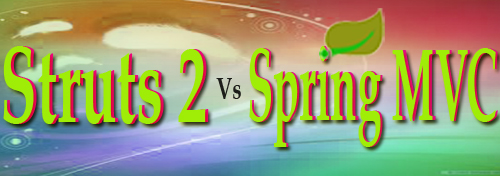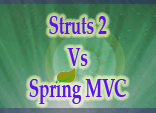In this article we are discussing the differences between Struts 2 and Spring MVC frameworks
In this article we are discussing the differences between Struts 2 and Spring MVC frameworks
Differences between Struts 2 and the Spring MVC frameworks: Familiarize yourself with the Difference and choose the best framework based on the requirement of the project.
If we talk about the functioning of both Apache Struts 2 and Spring MVC, then simply we can say that these two are the most popular and much talked about Java web frameworks today. Programmer and professionals have already acquainted with both the frameworks and many of you might have worked with it. However, despite something much similarity between its functioning, there are basic differences between both of these frameworks and the story highlights the facts about the Struts 2 vs. Spring MVC.
Both these frameworks are great choices for developing and deploying the today's demanding web and enterprise applications.

Let's understand the features of these frameworks one by one.
Struts 2: Features
Is that kind of framework which provides the situation in which the object that handles a request and routes for processing commonly known as action.
Apache Struts 2 is an elegant and extensible framework and it is used to create enterprise level Java web applications as per desired uses/requirements. It must be in our mind that it used to streamline the development cycle, starting from building to deployment and maintenance of the application.
You have liberty to use various kinds of tags like UI tags, control tags and other in this framework.
If you want to use JSP, Framework, velocity and other factors can use different kinds of results types here.
Here are the features of the Struts 2 framework in very short:
- In Struts 2 MVC components can be configured via struts.xml file
- Struts 2 action classes are simple POJO class
- Struts 2 provides the support for Ajax
- It can be integrated with the Hibernate, Spring, Tiles, Velocities etc...
- Many different formats are support for result construction such as JSP, freemarker, Velocity etc...
- Many different types of tags are available for the JSP, such as UI tags, Data tags, control tags etc...
- Struts 2 provides support for themes are templates
Spring MVC: Features
It is that kind of framework in which the very object is used to refer to the controller and needless to say the actions and controllers it received behaves equally in terms of input, process and return.
The Spring MVC framework is the implementation of famous Model-View-Controller design pattern as a model in the Spring Framework. This module (Spring MVC) is designed using the DispatcherServlet and it supports configurable handler mappings, view resolution, locale, time zone and theme resolution. It also provides the support for uploading the files. File upload functionality greatly helps the developers.
The @Controller and @RequestMapping annotations are used in Spring MVC framework.
It consists with leverage from the adaptability, now intrusiveness and flexibility with other controller method.
Differences between Struts 2 and Spring MVC
One of the major differences in Spring MVC and Struts 2 in terms of design is that Struts 2 Actions are newly instantiated every time a request is made, whereas in Spring MVC the default behavior is to act as a Singleton. Spring MVC Controllers are created once and held in memory/shared across all requests.
One of the major differences between Struts 2 and Spring MVC is that struts are a framework which provided a variety of Struts specific tags. The system provides the opportunity to set and use to assure that request parameters are bound to Action Form fields and show binding/validation errors. Surprisingly in Spring MVC, the main factor with this is that it has one simple bind tag that handles all of this. Your JSP's remain smaller and have more pure HTML content.
If we compare both the frameworks in terms of its implementation and validation, it is clear that with Struts, validation is usually performed in the validate method of an Action Form. The implementation is also important factors during this which clearly hints another form or tools during its validation. In other way, in Spring MVC, validators are business objects that are NOT dependent on the Servlet API which makes these validators to be reused in your business logic before persist a domain object to a database.


[ 0 ] Comments